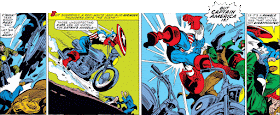Back in the '60s and '70s, man, motorcycle gangs had a certain reputation for intimidation and looking for trouble. But you almost had to admire them for having the stones to mix it up with the likes of
these guys.
Even before the Ghost Rider made the scene, Marvel characters were crossing paths with motorcyclists who didn't think twice about taking on a cornball in a far-out costume. Let's take a brief look and see how that generally worked out for them, eh?
We might as well start with Captain America--but what's his beef with motorcycle gangs? He can get along with practically anyone, even scruffy cyclists. For instance, we know he's in tight with Team America, a group he met doing a charity gig and later joined forces with to take on the mad Thinker.
But it seems even motorcyclists need a shield to the head when they get out of line. When Cap started riding his first cycle (that is, his first since his post-war days), he broke it in by taking on the Satan's Angels gang, who were giving some local kids some grief until Cap
VROOOMMed to the rescue.
And unlike his foes, we know that Cap has a way of inspiring those he's trying to protect--so it isn't long before the kids get tired of staying on the sidelines and leap in to give him a hand.
Unfortunately, tragedy strikes, when one of the cyclists who tries to bolt is responsible for his brother getting injured, which earns him an earful from Cap.
Another gang, however, doesn't get off so easy. When you cross paths with Dracula, you learn that your rash actions carry consequences--for YOU, that is.
It was easy enough to get the drop on Dracula when he was weak from blood loss--with his attackers treating him no differently than anyone else who was ripe to be victimized, and later making sure that their victim wouldn't be around to identify them. Of course, Dracula's pride would have him narrate a slightly
different version of what happened.
But the tables would turn for our cyclists when Dracula finally caught up with them and exacted his revenge. And suddenly, gunning their bikes' engines carried a more terrifying portent for our young hooligans.
San Francisco's Hellbirds turned out to be pretty rough on the streets even without their motorcycles--assuming these guys had any. Either way, it wouldn't make any difference to the one and only Hawkeye.
And what about going up against the Hulk? Isn't that a little suicidal, even for a motorcycle gang that collectively snarls in the face of danger? Gentlemen, you haven't
seen snarling.
The lady in the convertible is Lorna Dane, formerly one of the X-Men, who was out in the desert on her way to see Alex Summers (a/k/a Havok), who was isolating himself in order to keep from losing control of his deadly power and possibly injuring someone. As for the Hulk, he spotted Lorna's hair from one of his prodigious leaps, and assumed that his beloved Jarella was being threatened by our less-than-friendly gang members.
Once the Hulk catches up to the car, it looks like Lorna has dealt with her other attackers--but these bikers don't just look the other way when you mess with them, and one of them who has survived
both attacks comes looking for a little payback.
This just isn't Viking's and his buddies' day, is it.
Speaking of the X-Men, what does a group of students have to do to find a little spot in town for a surprise party when their Prof wants to be alone to experiment on his step-brother, the Juggernaut? Apparently the place to be isn't the Coffee-A-Go-Go, where Satan's Saints (probably related to Satan's Angels--maybe there's a Satan cyclist franchise) decide to cause a ruckus, and instead get blindsided by a surprisingly well-trained group of teens.
It looks like the reason the Saints are crashing the party here is all because their leader, Rocky Rhodes (heh, get it?) tried to hook up with Bobby Drake's date, Zelda, and was told to hit the rhode... er, road. Jeez, did the Saints ever pick the wrong time to make like tough guys.
All's well for the X-Men, it looks like. Not so much for the Saints, on their way to police lockup--their reputation as tough guys pretty much in the can. By the way, Rocky, Zelda's
really not into you now.



























































